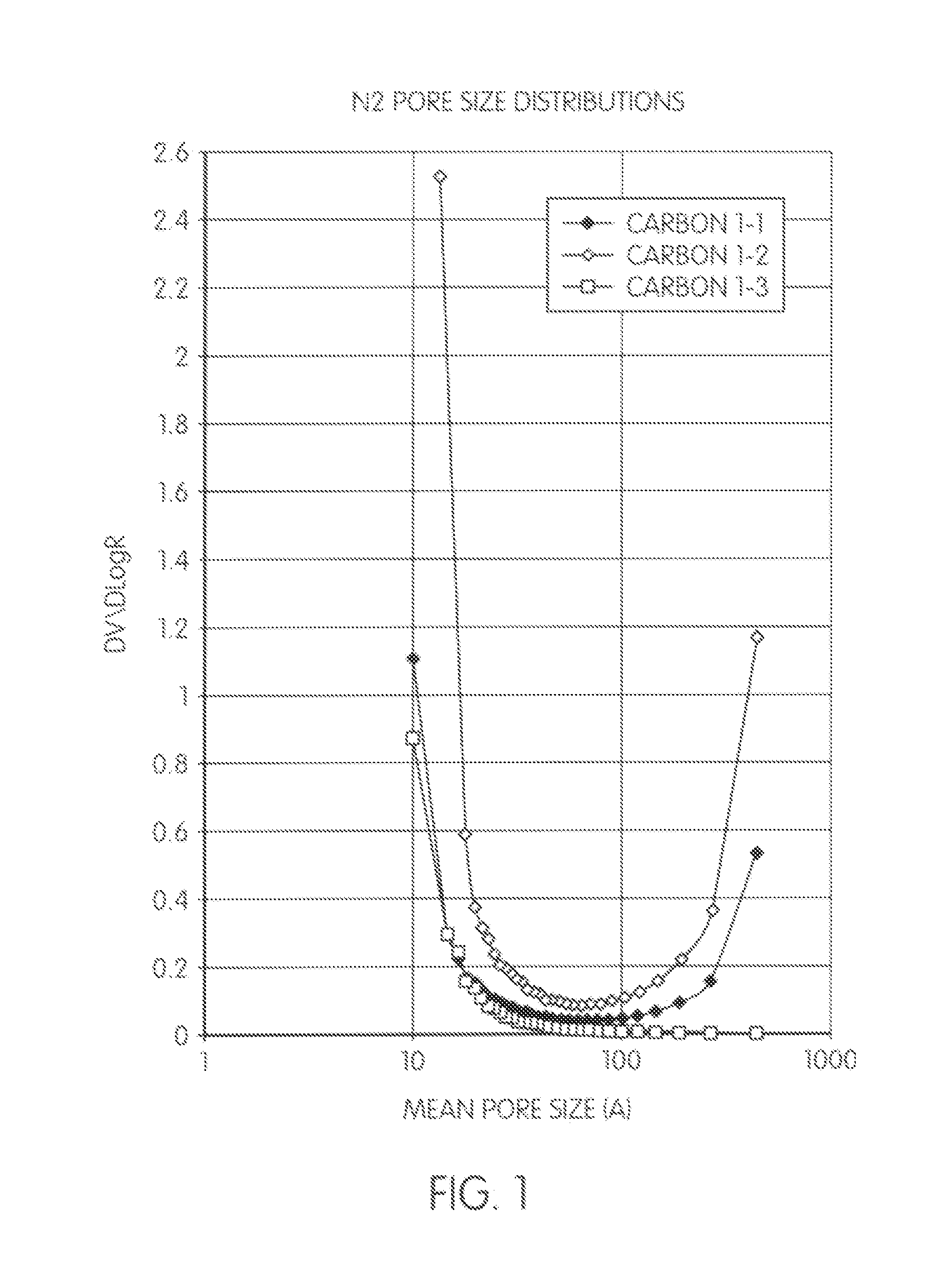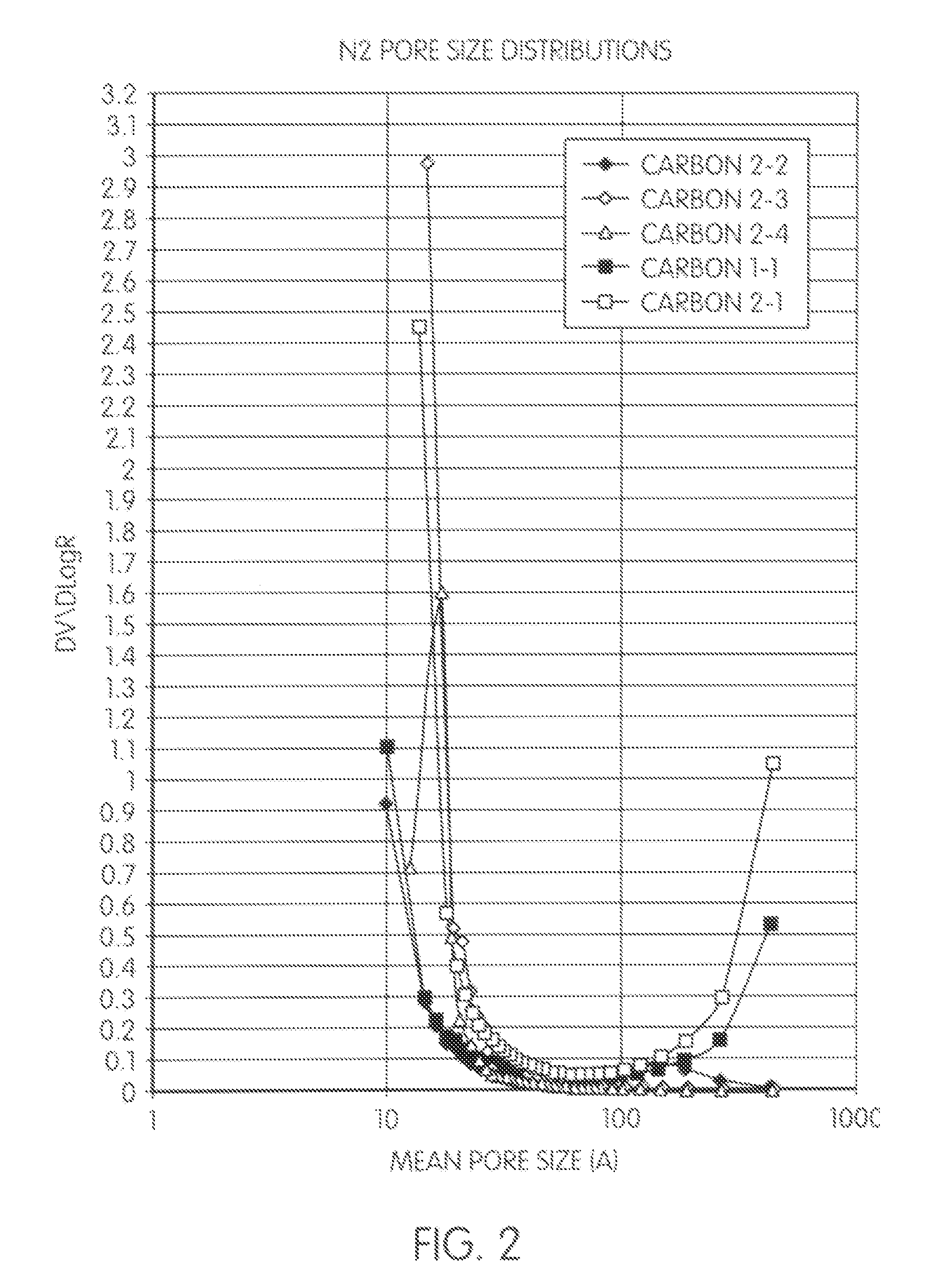Porous carbons
a technology of porous carbons and carbons, applied in the field of porous carbons, can solve the problems of reducing the mechanical properties of the carbon, affecting the formation of carbon, so as to increase the reaction rate, slow down the condensation reaction, and enhance the solubility and compatibility dramatic
- Summary
- Abstract
- Description
- Claims
- Application Information
AI Technical Summary
Benefits of technology
Problems solved by technology
Method used
Image
Examples
example 1
[0092]A reaction mixture containing 94 weight parts of phenol, 54 weight parts of paraformaldehyde (PF) (phenol to formaldehyde molar ratio 1:1.8), specified amounts of ethylene glycol (EG) pore former and concentrated sulphuric acid (SA) was heated with stirring up to specified condensation temperature (paraformaldehyde dissolves completely at about 60° C.) and maintained at this temperature for a specified residence time (Table 1-1).
TABLE 1-1EG,SA,CondensationResidence#weight partsweight partstemperature, ° C.time, minutes125935.472 ± 18023704577 ± 1120325917.072 ± 1300
[0093]The resulting viscous solution was poured as a stream into 2-4 volumes of stirred preheated (110-115° C.) mineral oil containing 0.5% of a drying oil, acting as a dispersing agent. The temperature of the resulting mixture dropped to ˜100-102° C., and cross-linking occurred normally within 1-2 minutes. The resulting slurry was gradually heated up to 115-120° within 30-60 minutes to complete the curing and coole...
example 2
[0095]A reaction mixture containing 94 weight parts of phenol, specified amounts of aniline (A), ethylene glycol pore former, paraformaldehyde and concentrated sulphuric acid was heated with stirring up to specified condensation temperature (complete paraformaldehyde dissolution occurs around 60° C.) and maintained at this temperature for specified residence time (see Table 2-1).
TABLE 2-1EG,PF,A,SA,weightweightweightweightCondensationResidence#partspartspartspartstemp. ° C.time, min.127256.74.737.273 ± 11052284599.33973 ± 11153310.564.818.642.473 ± 11404336.270.227.945.973 ± 1180
[0096]The resulting viscous solution was poured in a stream into 2-4 volumes of stirred preheated (110-115° C.) mineral oil containing 0.5% of the drying oil and the resin was processed further in the same way as in Example 1. The pore size distribution graphs and some structural parameters of carbons 2.1 to 2.4 and carbon 1.1 are compared in FIG. 2 and Table 2-2, in which is shown the effect of aniline cont...
example 3
[0097]Industrial Novolac resin in amount of 100 weight parts was mixed together with specified amount of ethylene glycol pore former (see Table 3-1) at elevated temperature and with stirring to enhance the formation of a clear solution, which was then cooled down to 65-70° C., where hexamine (HA) in amount of 9 weight parts was added. The resulting stirred mixture was gradually heated at such a rate as to reach the specified temperature in specified residence time (see Table 3-1).
TABLE 3-1Ultimate pre-CondensationEG, weightEG:condensationresidence time,#partsNovolac + HAtemp., ° C.min.11091.008530-352136.31.259030-353163.51.5010045-504190.81.7510270-7552182.0010475-806272.52.5010575-8073273.0010580-858381.53.5010680-8594364.0010785-90
[0098]The viscous solution was then poured in stream into 2-4 volumes of stirred preheated (115-120° C.) mineral oil containing 0.5% of the drying oil. The temperature of resulting emulsion dropped to 105-110° C., but on further heating cross-linking oc...
PUM
| Property | Measurement | Unit |
|---|---|---|
| Temperature | aaaaa | aaaaa |
| Radius | aaaaa | aaaaa |
| Nanoscale particle size | aaaaa | aaaaa |
Abstract
Description
Claims
Application Information
 Login to View More
Login to View More - R&D
- Intellectual Property
- Life Sciences
- Materials
- Tech Scout
- Unparalleled Data Quality
- Higher Quality Content
- 60% Fewer Hallucinations
Browse by: Latest US Patents, China's latest patents, Technical Efficacy Thesaurus, Application Domain, Technology Topic, Popular Technical Reports.
© 2025 PatSnap. All rights reserved.Legal|Privacy policy|Modern Slavery Act Transparency Statement|Sitemap|About US| Contact US: help@patsnap.com



